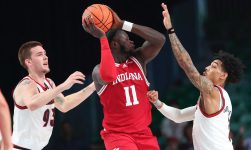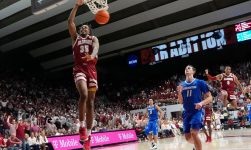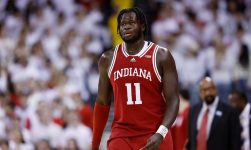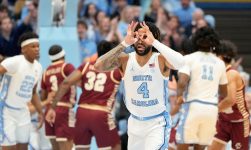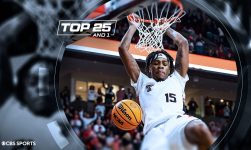The college players projected and expected to be picked in the first round of this year’s NBA Draft, for the most part, come from big-time programs and/or power-conference schools. A scan of the top prospects will show the likes of Duke, Gonzaga, Kentucky, Auburn, Iowa, Arizona, Baylor, Kansas, Wisconsin, Ohio State, LSU and more represented.
Then, an exception: Jalen Williams, who spent the past three years in obscurity playing in the West Coast Conference at Santa Clara.
“He’s the hottest player in the draft,” a league source told CBS Sports.
Williams’ stock has spiked in the past month. He might be as forceful of a late riser as the draft has seen in more than five years. The 6-foot-5 uber-wing seems on the precipice of morphing from being a fringe-guy-at-best a couple of months ago to being taken in the top 20. He also could wind up as the only player not from a big-name program and/or major-conference school to go in the first round. There are hundreds of really good players at mid-major programs. There are few great ones. Williams wasn’t even seen as “great” outside of his conference last season. Nonetheless, the tantalizing 21-year-old has elevated, and separated, himself. In doing so, he’s set to become the first NBA Draft pick out of Santa Clara since Steve Nash 26 years ago.
How does this happen? How does someone go from a mid-major prospect to changing the trajectory of his life like this? How does practically the entire NBA get so besotted so quickly?
How did you do this, Jalen Williams?
The text message that started it all
One of three children, you grow up in a household of accountability with your parents, Nicole and Ron Williams. They served in the United States Air Force, both having been stationed in Germany, South Korea, Japan and across the U.S. Mom a medical technician; Dad a senior master sergeant, who helped engineer military aircraft.
“As good of a family that I’ve ever been around,” Santa Clara assistant Jason Ludwig says. “Unbelievable people. They’re all about the right things.”
This is the coach who will one day discover you, Jalen.
You take to basketball from an early age, hoisting up shots on Air Force bases, then eventually showing your younger brother, Cody, how to play. Your love of hoops grows after settling in Arizona, once your dad retires from the Air Force. You move around the greater Phoenix area a few times, finding friends who have hoops at their houses.
You carry yourself with a natural confidence, thanks in part to your parents’ values. That military background keeps you accountable. Before you’re ever seen by a college coach, you already have the building blocks for one day making the NBA. But it takes so much more than that.
In your high school years you play for a non-scholastic team without a shoe-company sponsorship. A true spring/summer grassroots operation. On a Saturday morning in July 2017, your AAU coach blind-texts some D-I coaches to come and watch you play in Anaheim at the American Sports Center, a yawning warehouse-style facility with acres’ worth of courts. Your team has a game way, way, way in the back, situated near the field turf, on “Court 52” or something to that effect.
Ludwig gets these texts all the time and often ignores them. But, on a whim, goes to your game. He doesn’t know you, doesn’t know your coach. When he shows up, he’s the only coach watching you.
“He was just all arms and legs,” Ludwig remembers. “Feet were too big for his body.”
You’ve received a scholarship opportunity from only one Division I program at this point, but the thing is, it’s on the other side of the country. Hofstra’s interested, and they just offered you in the past week. Your play on that Saturday is good enough to make Ludwig take notes, add your info into his phone and put you on a preliminary list of 12-or-so targets in the high school class of 2019.
You’ll continue to get better, but scholarship offers won’t come in like you expect.
Six months later, while Ludwig is on a plane watching a video of you playing high school basketball, he’ll turn to his boss, Santa Clara coach Herb Sendek, and insist you deserve a scholarship. Thanks to already knowing your high school coach, Sam Duane, dating back to Ludwig’s time at Arizona State with Sendek, the staff will prioritize you. Santa Clara, Hofstra and UC Santa Barbara will recruit you, but everyone else will play footsie. Your skinny frame, lumbering feet and concerns over your athletic ceiling will cause too many coaching staffs to back off.
This places a chip on your shoulder. You’re underrecruited, and you know it. You understand it, though. Not everyone can see you play. You’re not on a Nike or Adidas or Under Armour team.
“I wasn’t playing to get an offer,” you say. “I was playing to have fun and compete and the offers fell where they were. I think it helped me weed out who wanted me. A lot of schools would call me, hype it up, not offer me and everyone was waiting to see when I would grow. … Go where you’re valued. I think that’s overlooked now.”
At this point you’re about 6-1 but with a promising 6-8 wingspan. You’re not even 180 pounds. But you’re not bothered by your frame. It’s something you’ve never even thought about. Comfortable as you. You probably don’t even know how valuable this will prove to be in the years to come. You’re lanky but you’re talented. Santa Clara wins out. That’s where you’re going to play in college. It ends up being the choice that will change the direction of your life.
“He’s the type of kid that’s easy to cheer for,” Ludwig says. “When you see someone like this have this opportunity and success, it’s so exciting. He’s so deserving. It’s extra special because you know what a great person he is and what a great family he comes from.”
Why Santa Clara was the perfect spot for growth
Tens of thousands of players have taken the same road as you. Though an outstanding feat on its own, you’re still merely good enough to be a Division I basketball player. The maneuver from here — turning yourself into an NBA pick — is unfathomably difficult. Fortunately, you chose the right school for you. You pick the place that allows you to grow into a role, to learn about yourself while you’re there — things you didn’t know before you left home.
When you get to campus, you’re longer, bigger, more athletic, more defensively adroit than your coaches anticipate. You’re not a starter, though. Not right away. But that only lasts until December, when it’s clear you’re too good to come off the bench. You replace an all-league-level player strictly because of how good you are on defense. By the end of your freshman year, your head coach sees you as a future point guard. Sendek has a vision, like how he had one when coaching James Harden at Arizona State and Julius Hodge at NC State.
Internally you already believe you’ll make the NBA ahead of schedule.
“I definitely would have told you by the end of my sophomore year I would have been declaring,” you say. You average 7.7 points, 2.8 rebounds and 1.9 assists in 25.5 minutes. You think: In a year, it will be my time.
The pandemic has other plans. Still, you come back in the fall of 2020 in outstanding shape, even without having a full-time strength and conditioning coach or an organized offseason. You’re better in pick-and-roll sets and you’re now the team’s best defender. That voice you use off the court is starting to emerge more on it.
“This dude had figured it out,” Santa Clara assistant Scott Garson says. “Guys that want to find a way to stay in shape and get better they just do. COVID can’t stop them, closing gyms can’t stop them.”
Ludwig starts to get a sense of something.
“I remember calling a coaching friend of mine and saying, ‘I think we might have a potential pro,'” Ludwig says.
The coach tells Ludwig he’s wacko. But Ludwig has been around future pros before. He coached Paul George and Klay Thompson as teenagers. At UCLA, he helped develop Russell Westbrook, Arron Afflalo and Jordan Farmar.
“I’m very hesitant to say those things,” Ludwig says. “I’ve been around it, so I know how hard it is. I’m very hesitant to use that word: pro. But you saw it in practice.”
Your sophomore year is a setback. The team isn’t allowed to play in Santa Clara County because of COVID protocols, so operations and life are moved to Santa Cruz. The Broncos play only 20 games. You live in a hotel for more than two months. It’s cold almost all the time by the Bay and you’re essentially not allowed to leave the premises anyway. Lockdown guidelines are strict. A homeless encampment can be seen outside your hotel. The team gets barely over two hours of practice time each day, on one court with only two hoops, at the local G League facility. You split time with other college teams. The makeshift film room doubles as a weight room in the hotel’s ballroom.
You average 11.5 points, 4.1 rebounds and 2.3 assists for a 12-8 Broncos team. You’re probably the third-best player. You’re not going to the NBA yet. But an offseason with a new strength coach, Ernie Contreras, is about to change your life again. You embrace the weight room. You grow a bit more — now to 6-4.5 inches without shoes — and upgrade your body. You only take 3-pointers from NBA distance in all workouts and practices.
Your genes are unlocking more of your potential.
Jalen Williams’ stock took off on a rocket once he dominated the combine.
Getty Images
Going into your junior year, your coaches expect you to be the No. 2 guy behind WCC all-league forward Josip Vrankic. After scrimmages vs. Oregon and Oregon State “it’s clear Jalen’s the best player on the floor and it’s not close,” Ludwig remembers. NBA teams don’t have you on their radar yet, but the buzz out of Santa Clara by November is enough to get a prospective agent to contact you. He tells you he thinks you’re going to be an NBA pick.
“In the back of my mind I’m like, shit, me too,” you say.
The shooting stroke your coaches saw in high school comes to fruition this past season. You’re effortlessly sinking shots all over the floor. You’re becoming more position-nimble. You can be a backup point guard but also thrive at shooting guard or small forward. Defensively, you take on just about any assignment.
You forward the agent’s number to your father. And the next one, then the next one.
Santa Clara opens the season 5-0, including wins over Stanford and TCU. You average 20.2 points. More agents are finding your dad. By early December, it’s starting to get to be too much. Eventually he turns off his phone at work. He can’t take all the calls. The text messages start to pile up. They’re finding his email, too. By early January, he fills you in on just how many people are asking him about you. It’s at this point you realize the dream is starting to get real, but you’ll push back those temptations as best you can and focus on the team. You don’t allow yourself to look at a mock draft until after your season ends.
Some scouts get the scent well before that. It’s the next key step in how a young man at Santa Clara finds a rocket into the first round. Scouts are coming to your games not just to see Gonzaga play you, but to see you play Gonzaga. The only two games in your junior season when you aren’t the best player on the floor are when you’re playing Chet Holmgren and Drew Timme.
In starting 33 games for a good Santa Clara team, you average the second-most points in the league (18.0) on 12.9 shots, plus 4.4 rebounds and 4.2 assists. You shoot 40% from 3-point range and 55% from inside the arc. Your free-throw average is 81%. Your assist rate is impressive for a 6-5 multi-dimensional wing.
You look the part. It’s more than promising; you seem viable. You could be an NBA player. At this point, it’s still a could be, though. So what is it, then? What gets you there?
“Even after the season ended, everyone had him as a fringe second-round guy,” Ludwig says. “But we knew people were missing the boat on him … we all were just waiting for the combine, all of us in our inner circle, our staff. We were just waiting for the combine because we knew he was going to test off the charts.”
The bigwig front office NBA guys on bad teams start to delve into the draft prospects as their seasons whittle away in late March. Turns out there’s this guy at Santa Clara who rates among the best in the sport in pick-and-roll efficiency. His transition numbers are very good. His touch around the rim is highly encouraging. His cutting ability is instinctual.
You owe it to yourself to investigate the possibility of being drafted. Sendek hands you the official slip for early entry. That’s when it seems real for the first time, you say.
And then life gets harder to manage than ever before.
The NBA Draft Combine changes everything
People really like you now, Jalen. It happens practically overnight. You get up shots in workouts, only to come back to your phone and see 20 missed calls and 30-plus new texts. People across basketball have found you on Instagram and are blowing up your DMs. You’re barely active on Twitter but you’ve got more than 100 direct messages waiting for you there as well. You’re the best Bronco since Steve Nash, so a litany of podcast requests also await.
“It’s like the COVID thing, and it was fun for the first two days, but then everyone wants you and you’re getting random calls, random texts and no names attached,” you say. “All these different numbers and you don’t know which one to answer, which one not. Looking back, it was awesome to be in that position because some people aren’t getting calls, but at the same time it’s just so chaotic. You have to keep your ringer on because some of these decisions can alter your life in a positive way.”
Other players could theoretically be in this situation, like you are, but they’re not. Almost no one is. They’re either going undrafted or didn’t receive enough positive feedback to warrant leaving college early. What makes you different?
“I think a lot of talented guys aren’t in the right situations to showcase their talents,” you say. “That was a big thing for me. … It’s a confidence thing. Going for it for me was working while everyone was asleep, not losing my end goal … and being true to what I was. Confidence was big for me, especially going through the middle of my time here. Keeping my confidence was big and belief in yourself.”
Relentless workouts at P3 in Santa Clara have your stock continuing to climb. Scouts aren’t allowed to see you until your Pro Day, but the chatter is getting louder. You’re outplaying guys rated higher at your position.
By the end of April, you’re a shoo-in to be picked if you opt to stay in.
How does this happen? You’re a rarity, that’s how. You use the oft-maligned NBA Combine to your benefit and embrace every element about it. Your approach to the combine is what changes everything for you forever. Dozens of prospects have their agents look to control images, testing and water down the event’s intended purpose. You want none of that. You don’t want to be hidden. You don’t want to be a mystery. Every team shows up in Chicago, where you easily rank among the five-or-so most intriguing prospects. Many are skeptical about the measurements that have previously been reported from Santa Clara to NBA teams. No way you’re as long and athletic as your school claims. No way.
“Because it’s Santa Clara, nobody believe-believes it,” Garson says.
Because here’s how it often goes: guys who are supposed to be 6-11 are 6-9 when officially measured at the combine. Wingspans routinely come in 3 inches shorter than advertised.
Except not with you.
You have your wingspan measured 12 times. Twelve. Times. It is as Santa Clara said it was: 7 feet, 2.3 inches on an NBA-ready 6-5 frame. You rank No. 1 in wingspan margin.
“We knew,” Garson says. “When that happened that was a huge eye-opener to people, I knew it would be, but it was huge. We started getting phone calls left and right before he played in the combine.”
You’re scheduled to meet with 13 teams. Then two more want to talk to you. They want to talk to you because you’re arguably the winner of the combine before you’re even done doing everything in Chicago. How does someone go from Santa Clara to a first-round draft pick in 2022? They show up, don’t dodge playing 5-on-5, and look good in the first game. Most prospects would be advised to skip the second game the next day. Teams ask if you’re going to play again. Of course you’re going to play again. The days of hiding somebody to give off that aura of having something special, that jig is up. Teams are now rewarding players if they play in the combine and play well. General managers want to reward the ones who aren’t afraid.
“I feel like a lot of players for whatever reason decided that’s not for them, but I sure as hell didn’t fly to Chicago to not play,” you say.
Since you’re from Santa Clara, general managers still want you to prove you can play with talent — more than what was around you in the WCC. That makes you laugh. Your plan, the whole time, is to invest as much of yourself in the combine as possible. In the second game, you score 19 points on 7-of-8 shooting. You’re not even playing to increase your stock; you’re just playing because it’s fun.
When you’re not playing, you finish second in standing vertical leap (33.5 inches). Your max vertical leap is top-five among all entrants (39 inches). Your standing reach: a wowing 8 feet, 9.5 inches for someone who will likely play the 2 at the next level. In shuttle, you rank high. In three-court sprint, a 3.1-second time at 210 pounds. Elite. The suspicions over your athleticism get obliterated.
This is how it happens. This is how you turn into the hottest prospect in less than six weeks’ time. It’s so exciting, you don’t mind much that you accidentally packed the wrong pair of jeans and wear bell-bottoms to your interviews.
On the 27th floor of the Marriott Marquis Chicago, teams wait in hotel rooms that have had the beds removed to make space for as many as 10 bodies sitting, you at the center of them. The questions are predictable, repetitive. Every meeting is 25 minutes: 8:30-8:55 with one team, 9-9:25 with another and so on. It’s chaotic and a mental drain, but it’s amazing. You interview with Brooklyn at one point. Steve Nash, the Santa Clara legend himself, is there.
“I think it was cool to even be in the same room as him, going through that process, just to know me and him are bonded in that way,” you say.
The combine ends. Next: team workouts in cities across the country. The Clippers, Warriors, Nuggets, Grizzlies, Bucks and Spurs come first. Then Minnesota. At least four more will come after that. You say you’ll do 100 workouts for all 30 teams. You want every opportunity, because every opportunity is another future that could await.
The workouts are mostly the same. Fly in the night before. Wake up early. Get to the team facility and either play some 3-on-3, 1-on-1 or go through medical testing. That’s the most tedious part. You measure again and again, and that abnormal wingspan is catching teams’ attention. It’s the same every time. They also want to see how far your knees bend, or how far they don’t. Do your toes hurt? Which leg is stronger? Now go through cardio testing. And more interviews.
By early afternoon, you’re already heading back to another airport.
“I think that’s the one thing that’s been so crazy is you go so fast, it happens so fast,” you say. “The Spurs workout went by so fast, I’m already back at school, and just two days ago I was so excited about that workout.”
Are you the next small-school player who will make it big in the NBA, Jalen Williams?
“At the end of the day if you can hoop, you can hoop,” you say. “And if you can’t, you can’t. That’s the bottom line of where it is. Dame, C.J., Klay, Steph Curry’s going to be one of the greatest players ever and went to Davidson. The small-school thing doesn’t really matter to me. There’s always going to be naysayers.”
It’s almost time to pack up for good from Santa Clara. You’re fresh off a workout, putting your belongings into boxes. It’s getting close to your last days here. You’re enjoying your final weeks of being a non-professional. At this point, it’s hard because you’ve done all you can do.
“I think he’s going to be a longtime NBA player. I’d be shocked if he wasn’t,” Garson says. “He’s only going to get better next year. The guy’s not close to a finished product, not even close.”
Garson’s also coached former would-be pros, guys like Westbrook, Zach LaVine and former No. 1 pick Andrew Bogut. There’s less than two weeks until draft night, and the buzz is you’re pacing to top-20 status. Maybe even top 15, if the right team is waiting for you.
“You can’t truly prepare to be in this moment until you’re in it,” you say.
That’s the funny thing. You’ve actually prepared for this moment your whole life. You’re the biggest surprise story of the 2022 NBA Draft, and the only one who ever saw it coming this soon was you.

